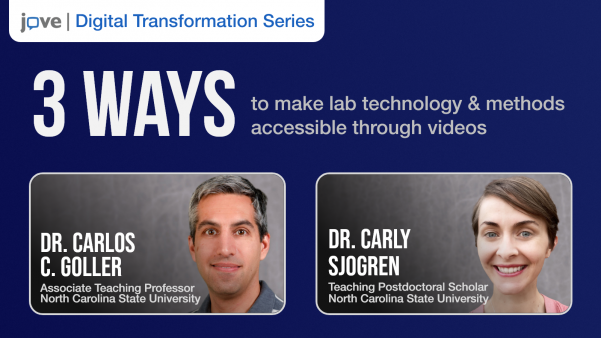Digital transformation in Higher Education has become crucial for enhancing learning experiences. Bringing digital resources like videos into STEM classrooms promotes interactive learning, accessibility and discussion. With this series, we aim to emphasize stories of STEM instructors using digital media and technology for an overall improved student experience.
Dr. Carlos C. Goller is an Associate Teaching Professor in the Department of Biological Sciences and teaches in the Biotechnology Program at North Carolina State University. His research interests include molecular microbiology, metagenomics and epidemiology. He designs and teaches various biotechnology courses using JoVE videos.
Dr. Carly Sjogren is a Postdoctoral Teaching Scholar in the Biotechnology Teaching Program at North Carolina State University. She teaches courses in the Biotechnology Program like High Throughput Discovery along with Dr. Carlos, where they use JoVE videos as part of critical thinking scenarios, and Comparative Plant Transcriptomics, where she generates JoVE content with undergraduate and graduate students researchers.
Here are three key takeaways from a recent webinar where STEM instructors Dr. Carlos C. Goller and Dr. Carly Sjogren talked about using video resources in their research courses to amplify student access to science.
1. JoVE videos for delivering cutting-edge research directly to students
Dr. Carlos discussed using JoVE videos to deliver cutting-edge research to their undergraduate and graduate students in their advanced research courses. He explained how JoVE videos are a great way to;
a. make different scientific techniques accessible to students, especially in labs with limited resources or virtual spaces.
b. help students learn first-hand from scientists performing field research and methods not feasible within the confines of a classroom or in a time-bound course of just eight weeks.
c. effectively communicate intricate details of the experimental protocol instrumentation, and scientific data, helping students build lab skill sets and analytical thinking.
Check out JoVE: Encyclopedia of Experiments for online video encyclopedias of advanced research experiments for scientists in academia and biotech. To request a trial click here.
2. JoVE videos for creating critical thinking assignments
Dr. Carlos and Dr. Carly merged learning science into a fun exploratory space within the course; Dr. Carly said, “As a researcher, one of the goals that I’ve set for myself when I want to experiment is that I look up to someone in my field who has a method that I can learn from and experiment myself to test my question, confirm or deny my hypothesis. Enabling my students to follow the same method through JoVE is easy through these critical thinking assignments. It’s a joy to blend research and life-like video resources into the classroom.”
Here’s an example of a JoVE video article High-throughput, Automated Extraction of DNA and RNA from Clinical Samples using TruTip Technology on Common Liquid Handling Robots, used in a critical thinking assignment along with the content check questions such as;
- What was the overall goal of this protocol?
- What are three advantages to using this technology, and
- What makes this protocol high throughput?
To boost student engagement and learning by teaching science courses with technology, JoVE offers dedicated support to help you save time and effort on integrating science videos into your courses. Get in touch here.
3. JoVE-style manuscript writing
The speakers highlight that teaching with JoVE research publications in their STEM class helps students create their own manuscripts using the highly detailed JoVE manuscripts template, supporting the process of designing an experiment on their own when provided with a biological question. Being the world’s most prominent peer-reviewed scientific video journal, JoVE provides a highly structured approach for publication. Dr. Carly explained that the JoVE manuscript template had been the best tool for the lab research project to teach their students scientific research and the learning process.
During the webinar, they mentioned that teaching with JoVE resources makes faculty’s life easy and learning for students fun. No matter where students are, they can learn how to perform experiments through these videos without limitations to the environment, geographical location, etc. Learning with videos facilitates discussions that are truly powerful in creating connections between students and a sense of community in an asynchronous course like theirs.
Request a full recording of this webinar to know more about using digital tools to engage students.


